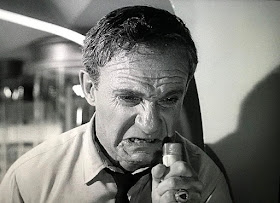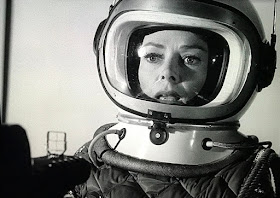


Following the epic fantastic that was Irwin Allen's pilot for Lost In Space, No Place To Hide, Allen and Shimon Wincelberg and others revisited the idea of adding a villainous element to the family dynamic of the series.

Scriptwriter Wincelberg noted in Lost In Space Vol.1: The Authorized Biography Of A Classic Sci-Fi Series (p.224), "The role of Dr. Smith was only an afterthought altogether. It wasn't in my original script; It wasn't in Irwin Allen's original prospectus. It was only when we brought in a story editor. I think it was the late Tony Wilson who suddenly came up with the idea about, 'Yeah, how are we going to get stories week after week?' And we all realized what we needed was an irritant, a colorful character like Long John Silver in Treasure Island - somebody who could relate well to the boy but who would still be basically a troublemaker. And that's how Dr. Smith was created, and I wrote him into my script [for The Reluctant Stowaway]."

Wincelberg added regarding the character of Smith, "Smith was interesting because he was a child. He had the willfulness of a child, a weak sense of consequence" (p.225). And Jonathan Harris came to embody that.
The other big edition was Robot and Wincelberg noted "Robot was there, but he wasn't all that important" (p.236). My how that would change. Though he didn't recall when Robot became important, the addition of both Smith and Robot to the series was essential influencing the trajectory of the series and space family Robinson.

Further, Smith, Robot and Will Robinson would assume the forefront of the series as the focus would move to them into the series second and third seasons.
Initially, Wincelberg noted Robot was there "for emergencies." His presence was intended to be a threat--- the distrust or imperfection of technology as it would one day manifest in a series like Space:1999 (1975-1977). So in the early going Robot was not essential and the series broke down No Place To Hide for the first five episodes.

Robot, designed by Bob Kinoshita, the man behind Robby The Robot from Forbidden Planet (1956), put together Robot for a small sum of just $36,000 dollars. Fortunately his design stamp was strong because Robot would be crucial to Lost In Space for years to come, memorable and ultimately iconic. So with Bob May in place to offer Robot his physical personality and Dick Tufeld secured as the voice of Robot, Lost In Space was launched with Lost In Space, Season One, Episode One, The Reluctant Stowaway.
Director Tony Leader was brought in to film a largely new entry utilizing a portion of No Place To Hide. Leader was also sought to inject a much needed infusion of character and family dynamic into the previously adventure-heavy pilot.

The resulting The Reluctant Stowaway had all of the ingredients. Character dynamics abound, conflict, a touch of humor and all of it drenched in gorgeous black and white noir, compliments of the season's director of photography Gene Polito (absent only from The Magic Mirror as he worked on War Of The Robots).
The Reluctant Stowaway's incredible cast is a huge part of this opener's success and the series' long term success. I do mean incredible. Guy Williams, June Lockhart, Mark Goddard, Marta Kristen, Angela Cartwright, Bill Mumy and "special guest star" Jonathan Harris are truly flawless with chemistry abound. Robot too is perfection in design thanks to the mind of Kinoshita. Robot is as iconic as The Eagle of Space:1999, Thunderbird 2 of Thunderbirds (1965-1966) and even a creation like Godzilla itself. Robot is immaculate in conception.

Additionally along with that severe, stark noir look was the unseen character of composer Johnny Williams as he accents the series with a stark, sometimes ominous always beautifully assembled score of themes. It is something the ear must behold. Williams' theme would permeate the entirety of the season and return in parts throughout the entire thress seasons of the series. Williams would return for Irwin Allen to score the third season theme as well as scoring for Allen's The Time Tunnel (1966-1967), Land Of The Giants (1968-1970), The Poseidon Adventure (1972) and The Towering Inferno (1974). Williams was a busy man and would only get busier.
Lost In Space turned down the busy effects work of Allen's beloved pilot, No Place To Hide, an almost demo like calling card for what the series could offer, breaking it down and infusing it with family drama and coming up with the foundation and critical ingredients that were required to endure for three seasons.

Some of the notable differences between the pilot and this series opener is that The Reluctant Stowaway spends much more time in mission control, performs a walkthrough styled examination of the Jupiter 2 (formerly the Gemini 12), offers extensive launch preparations, introduces Robot and villainous foreign agent Dr. Zachary Smith (trapped).
There is a notable exchange and scene that foreshadows the crucial dynamic of the series between Dr. Smith and Will Robinson. It is amusing, slightly comedic and exceptionally well performed and executed. It was a sign of things to come for the Smith character and it is precisely this scene that would capture the hearts of Lost In Space fans who clamored for more of Smith, Will and Robot as the series would endure. While at first a real villain there was something magical to the tightrope walked by Jonathan Harris as the series progressed and the scene here is evocative of how he would play the character and step between the worlds of villain and cowardly survivalist. It's a fascinating tour de force performance by Harris across three seasons all the criticisms and aspersions aside. Harris was indeed critical to Lost In Space and to fans of the show.

While not as expensive as the pilot, The Reluctant Stowaway still cost nearly $200,000 dollars and the episode was worth every penny.
The Reluctant Stowaway draws upon footage from No Place To Hide but includes a sizable amount of new footage filmed for the series featuring both Dr. Smith and Robot. The Reluctant Stowaway is an exceptional first episode and a real testament to the skills and art of editing in television. But the infusion of Smith and Robot to an already incredible cast makes the launch of this series really take off.

Written by Irwin Allen and Shimon Wincelberg (as S. Bar-David; Wincelberg preferred his name not appear given the many changes to his script despite it being an excellent entry), The Reluctant Stowaway is a remarkable and radical departure from the pilot given all of the new material, truly launching the series into outer space with the promise of a great many things to come.
Writer: S. Bar David (Shimon Wincelberg).
Director: Anton (Tony) Leader.

My desire to revisit Lost In Space from the very beginning, following coverage here of the pilot No Place To Hide, was the result of the series being gloriously restored on Blu-Ray. It's the best you'll ever have to experience the series. The chance to offer you new images of the series and a new appreciation for it simply could not be passed up. Additionally, as a writer, I've tightened eschewing a tendency to summarize stories rather than simply offer my musings. I wanted to right that ship here for Lost In Space.
The first episode comes with a very informative and interesting commentary track by Ken Burns and Starlog writer Mike Clark. TV history and Lost In Space geeks will rejoice.

This writer originally wrote about Lost In Space through some unfairly critical eyes. Having seen the Netflix series reboot, remakes of V (2009-2011), and a host of other terrible and terrific science fiction I felt stepping back in time for a fair assessment was required. Lost In Space is so much apart of science fiction fans of my generation that a proper assessment was due.
Appreciating the full artistry by all involved on The Reluctant Stowaway and season one reveals there was something incredibly special happening and it remains unchanged by time. I can only assure you this is a science fiction classic for a reason. Sure flaws exist, and those are memorable too, but this is a wonderfully entertaining slice of science fiction entertainment that still blows me away fifty years after its original airing. As we look back at this series this writer will unabashedly be giving the show the love and respect it rightfully deserves.


































































This is GREAT. Thank you.
ReplyDelete